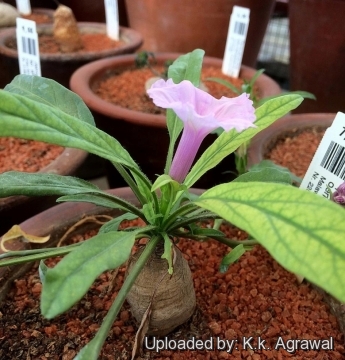Accepted Scientific Name: Ipomoea oenotherae (Vatke) Hallier f.
Bot. Jahrb. Syst. 18(1-2): 125. 1893 [22 Dec 1893]

Convolvulus oenotherae (Ipomoea oenotherae) Photo by: Sándor Horváth
Origin and Habitat: Ethiopia, Somalia, Kenya, Uganda, Tanzania, Malawi, Zambia, Zimbabwe, Botswana, Namibia and Mpumalanga, South Africa N,W,C.
Altitude: 500-1615(-2070) metres above sea level.
Habitat: Mixed woodland, grassland and sandy soil
Ecology: Ipomoea oenotheraeSN|23118]]SN|23118]] is a cryptophyte occourring in sandy soil in mixed woodland and grassland. In the dry season its root and buds are underground, leaving no trace on the surface of the soil. When the rains come it sprouts, flowers, fruits and dies back, all within a few weeks.
Synonyms:
See all synonyms of Ipomoea oenotherae
Description: Ipomoea oenotheraeSN|23118]]SN|23118]] is a prostrate or ascending perennial herb with numerous stems up to 30 cm long growing from a tuberous rootstock. The leaves are variable in form and size. The mauve to violet flowers are narrowly funnel-shaped up to 5 centimetres long. The plant flowers during the summer.
Tuberose rootstock (caudex): Fusiform 3 centimetres in diameter.
Annual stems: Numerous, slender, 15-30(-50) cm long, prostrate or ascending, angular, densely white-pilose above, glabrescent beneath.
Leaves: Very variable (polymorphous), white pilose above to nearly glabrous beneth, the basal ones largest rosulate, (if present) long petiolate with a petiole up to 5 cm. long; Leaf lamina lanceolate or linear, up to 6 × 1 cm., entire or with 1–2 lateral teeth or lobes or repando-pinnatisect 2–7(–9)–lobed or rarely entire or undulate, cauline linear-oblong, 3-4 cm long and about 1-.5 cm wide, all subacute, repand (sometimes with one or two teeth near the base), narrowed to the base.
Flowers: Axillary, solitary, subsessile or with a pedicel up to 15 mm, narrowly funnel-shaped with spreading limb, tubular below; light pink with a darker throat, mauve or purple, 2–4(-5) cm long and broad. Peduncles 1-flowered, about 2,5 cm long. Sepals ovate, acuminate, subaristate, under 13 mm long, outer broader than the inner, bracteoles linear-subulate or linear-filiform, 10-15 × 0.5 mm., pubescent. Calyx densely long-pilose, 1.2 cm long,
Fruit: Capsule globose, 6 mm in diameter glabrous, straw-coloured.
Seeds: Densely appressed with dense white or grey hairs.
Bibliography: Major references and further lectures
1) Gonçalves, M.L. . “Convolvulaceae Flora Zambesiaca” 8(1) Page 65. 1987
2) Hyde, M.A., Wursten, B.T., Ballings, P. & Coates Palgrave, M. (2016). “Flora of Zimbabwe: Species information: Ipomoea oenotherae var. oenotherae.” http://www.zimbabweflora.co.zw/speciesdata/species.php?species_id=147890, retrieved 8 January 2016
3) Wikipedia contributors. "Ipomoea oenotherae." Wikipedia, The Free Encyclopedia. Wikipedia, The Free Encyclopedia, 12 Oct. 2015. Web. 7 Jan. 2016.
4) J. G. Baker and C. H. Wright.“Flora Capensis”, Vol 4, page 45, 1904
5) Eggli, Urs; Newton, Leonard E. "Etymological Dictionary of Succulent Plant Names". Springer-Verlag Berlin Heidelberg. Birkhäuser 2004
6) Verdcourt, B. "Flora of Tropical East Africa". 1963 <http://plants.jstor.org/stable/10.5555/al.ap.flora.ftea001228> Retrieved 27 July 2015.
7) M.A. García (Cuscuta), Sebsebe Demissew (Cladostigma, Hildebrandtia, Seddera), and M. Thulin (Astripomoea, Convolvulus, Cressa, Dichondra, Evolvulus, Hewittia, Hyalocystis, Ipomoea, Jacquemontia, Merremia, Operculina, Stictocardia, Turbina, Xenostegia) “Flora Somalia”, Vol 3, (2006) [updated by M. Thulin 2008]
8) J.P. Roux “Flora of South Africa”, 2003
9) Urs Eggli “Illustrated Handbook of Succulent Plants: Dicotyledons” Springer Science & Business Media, 2002
10) J. O. Kokwaro, Timothy Johns “Luo Biological Dictionary” East African Publishers, 1998
 Convolvulus oenotherae (Ipomoea oenotherae) Photo by: Valentino Vallicelli
Convolvulus oenotherae (Ipomoea oenotherae) Photo by: Valentino Vallicelli Convolvulus oenotherae (Ipomoea oenotherae) Photo by: K.k. Agrawal
Convolvulus oenotherae (Ipomoea oenotherae) Photo by: K.k. AgrawalCultivation and Propagation: Ipomoea oenotheraeSN|23118]]SN|23118]] is easy to grow and puts on a fanciful display, but it takes years to develop and is not a plant for the impatient gardener.
Light requirements:* Give it plenty of sun or high interior lighting and freely circulating air, but keep the caudex bulb shaded.
Soil: It needs a well-drained soil mix (e.g. use a mixture for cactus + normal potting soil) with the caudex planted largely above the soil surface. A clay pot is best. It can be planted “on” the ground, it will root soon, and the chances of getting rot are smaller this way rather than planted underground (although it grows more slowly).
Water requirements: It needs regular watering during the active growing season without too much water. Let the soil become rather dry before watering again. Stop watering gradually when the stalk dries out after blooming in summer, or else the caudex may rot. During the winter months, the plant will drop all of its leaves and no water should be given during this period. Start watering when the stalk starts growing again in late winter.
Fertilization: If fertilizer is used, it should be diluted to ¼ (one-quarter) the recommended rate on the label.
Hardiness:* It is a frost tender species that must be protected in the greenhouse over the winter (Avoid any frost!). If grown in the home environment, the ideal temperatures should run between 20° to 30° C with winter time temperatures around 10°C. Protect from heat in summer.
Uses: Ipomoea oenotheraeSN|23118]]SN|23118]] has an edible tuber eaten raw by shepherds.












